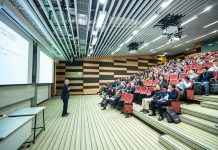Even while driving a car you can meditate. This meditation will put in perspective your creative thinking, social values, and human values in general, as the main framework for success.
Let’s take one example. You are driving on a sunny day along the major highway. The signs are passing by. For instance, there is a sign “Airport ahead” which is a silhouette of an airplane, top view. Painted in green.
You start with the key observation: nothing needs to be as it is. In your mind you find what is it about this sign of an airplane that needs not to be as it is.
First of all, there may not be a sign there at all. Just the highway and trees on its sides. So, somebody has to come up with the idea to put the sign there. It’s a postulate. But, why this particular sign? Because the road comes close to the airport, next exit maybe. Yet, the airport needs to be there. Somebody built it but it needed not to happen. The reason why it’s built is people had a need to travel from that particular region. City planners did research, some statistical measurements when and how people travelled before, and then put up the discussion at city hall if a new airport is a feasible solution. Here you have exact application of Premise based implicative Truth Synthesis. First, let’s postulate that people travel. People want to travel faster. It’s their free will. Now, what to do about that? The need to travel faster can imply something. But, it’s not causative implication. There is no direct causation between “people need to travel faster” and “we are going to build an airport”. This implication is non-causative because it refers to our free will to do something, anything. The first does not automatically imply the second! Only when we decide and promise to take a certain action the implication comes to life. So, we rephrase. “People need to travel faster” implies that we take action “to build an airport”. We were free to build anything. Maybe a railway. Or new lanes of the highway. Yet, after thorough study we decided to build an airport. Thus, a new truth is synthesised by our actions: “People need to travel faster implies that we made a decision to build an airport”. This is the key of creative thinking.
You can notice how the simple look of the traffic sign, containing an image of airplane, can outline the framework of creative thinking. Here is the summary. First, we identified premises, postulates. Then, we put that in a social context. It is imperative here to note that in order to succeed, we need to put our system into social context, what members of society value and what actions they will take based on their values which drive their motivation to act. Next we used Implicative Truth Synthesis. We created a new truth by analysing present state and possible future human behaviour (here to travel faster by airplane). Note here how free will is centra. People will make their decision to fly by airplane motivated by their desire to travel faster. And you built that airport! Of course that might lead to innovation regarding airplane types, fuel efficiency, capacity of seats, etc.
Back to the sign. It is built for you, because the traffic engineers and highway planners know that you may need this information while driving there. They postulated that fact. It was their starting point – drivers need the information as to where the airport is. Without that information the engineers and designers would not take any action designing the sign and putting it at certain locations.
You can see how that postulate acted as a bootstrap for their creative actions.
Talking about engineers, you may notice the bounds of their profession. They deal with geographic locations, draw a sign, cut the sheet of metal, put the sign together and put it on the highway. That’s their job. I can bet they alone did not decide if that action is to be taken. Most likely, a city planner or traffic planner did that.
In order to be an entrepreneur, you need to have a sensibility for human desires, interests, needs, and above all what they value. Technical education is fine, university education is fine, but it is not alone sufficient to becoming a successful entrepreneur. You need Premise based Implicative Truth Synthesis to connect your business plan, home business or CEO level projects with social net, with human values. Then you can plan, maybe become a director and direct others, engineers, architects, civil engineers to act within their profession. The same can be applied for any home business project as well.
I put emphasis on meditation, because with meditation you will become accustomed to the right way of thinking. You start with the observation “this need not to be as it is” which leads to the preceding events and motivation as to why it is as it is, uncovering on the way of your analysis the postulates, human motivation, social and human values, social context embedded with actions driven by Implicative Truth Synthesis. Soon, you will be so used to this way of thinking that you will do the crown of the method – connected, at the first sight, unrelated systems, which is by definition the core of creative success and innovative thinking.
Find a Home-Based Business to Start-Up >>> Hundreds of Business Listings.

















































